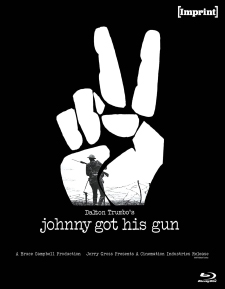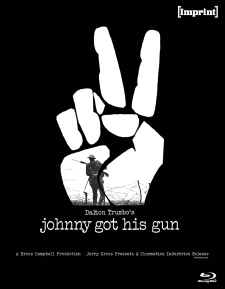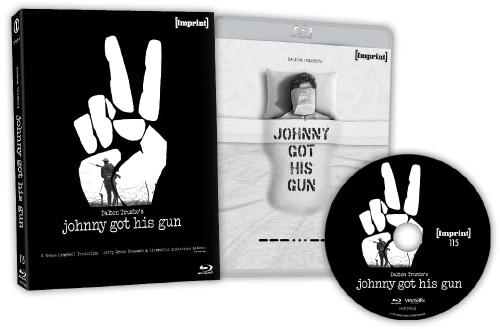Johnny Got His Gun (Blu-ray Review)

Director
Dalton TrumboRelease Date(s)
1971 (April 8, 2022)Studio(s)
World Entertainment/Cinemation Industries (Imprint/Via Vision)- Film/Program Grade: B-
- Video Grade: A-
- Audio Grade: B+
- Extras Grade: A
Review
[Editor’s Note: This is a REGION-FREE Australian Blu-ray import.]
Dalton Trumbo is best known today as one of the Hollywood Ten who refused to buckle under pressure from the House Un-American Activities Committee to divulge names of those who might have had affiliations with the Communist party. He was also a successful screenwriter for such films as Thirty Seconds Over Tokyo, Roman Holiday, Spartacus, Lonely Are the Brave, and Papillon. He directed only one film during his long career—Johnny Got His Gun—based on his own novel.
Joe Bonham (Timothy Bottoms) works in a bakery to support his mother and sisters after his father’s death and is in love with Kareen (Kathy Fields). During World War I, he enlists in the army and months later is sent on a patrol into no-man’s land. A shell explodes near him and the next thing he remembers is waking in a hospital, his body covered in sheets and his face heavily bandaged. Gradually he discovers the extent of his injuries. He’s lost both of his arms and his legs and most of his face. He can’t see or speak and must be fed only intravenously. The army doctors are convinced he has no conscious mind. Nevertheless, they decide to keep him alive.
Joe’s mind, however, is crystal clear. As he lies in an endless limbo with nothing to do but think, we see flashbacks to his early home life with his mother (Marsha Hunt) and father (Jason Robards) and experience his fantasies, especially a meeting with Jesus Christ (Donald Sutherland), who can’t help him figure out a way to accept life with his devastating injuries.
The present is depicted in black-and-white while the flashbacks and Joe’s fantasies are shown in color. The film is powerful but lacks the deft touch of an experienced director. Released originally during the Vietnam War, the film had a contemporary resonance. Now, with a new war in Ukraine, the theme once again has a palpable significance.
Unlike many anti-war films, Johnny Got His Gun does not make broad political statements, focusing instead on a single life destroyed by war. Because we see Joe as a typical rural American kid who joins up because he feels it’s the right thing to do, we empathize with his plight and recognize the enduring consequences of war.
Bottoms does a good job of portraying Joe’s Norman Rockwell boyhood. After his injuries, the only reality he knows is his own consciousness, memories, and fantasies, all of which we see unfold. Even though the doctors claim he has “complete cerebral disconnection,” his mind is perfectly lucid and he feels utter despair at being a prisoner in what’s left of his body. Only a compassionate nurse (Diane Varsi) develops a silent bond with him. Eventually, through jerky movements of his head, Joe manages to communicate in Morse code, making two requests, both devastating but making perfect sense considering that life has become his worst enemy.
Johnny Got His Gun was shot by director of photography Jules Brenner with Panavision cameras and lenses on 35 mm film, finished photochemically, and presented in the aspect ratio of 1.66:1. The Imprint Films Blu-ray release features picture quality that’s sharp and well detailed. Hospital scenes were shot on color film but desaturated to black-and-white, while flashbacks and Joe’s fantasies remain in color. The flashbacks have a yellowish tint, with pasty flesh tones. The hospital scenes are somber, with dim light and pronounced shadows. Blacks are deep and velvety. The cinematography is fairly straightforward with only a single use each of a zoom, split screen, and a dreamlike image created by smearing Vaseline on the lens. In a few instances, characters completely disappear into blackness, a common stage lighting device. After a title sequence showing archival footage of World War I, the screen goes totally black for several seconds. Many scenes of Joe in the hospital resemble The Twilight Zone episode in which a woman, her face heavily bandaged, lies in bed in a darkened hospital room, hoping the surgery on her face was a success.
The soundtrack is English 2.0 Dual Mono LPCM with optional subtitles in English SDH. Dialogue is clear, with doctors and military men discussing Joe’s injuries with detachment and a lack of empathy. Bottoms’ monologues communicate Joe’s thoughts when he no longer can. With his face unseen, his performance in the hospital scenes relies entirely on the emotions in his voice. A shell explodes, creating a loud boom, a heavy downpour turns the ground into mud, and period trucks, cars, and ambulances emit vintage engine sounds. Jerry Fielding’s music, with beautiful use of oboes and flutes, plays through most scenes and has a plaintive quality. A chorus of women’s voices adds depth. Occasionally there’s a repeating military drumbeat.
Bonus materials on Imprint’s Blu-ray release include the following:
- Audio Commentary with Matthew Asprey Gear
- Dalton Trumbo: Rebel in Hollywood (59:11)
- Interview with Timothy Bottoms (10:29)
- Behind-the-Scenes Footage with Commentary by Timothy Bottoms and Jules Brenner (8:10)
- 1940 Radio Adaptation (29:54)
- Theatrical Trailer (1:42)
In the audio commentary, cinema author and critic Matthew Gear discusses Dalton Trumbo’s 1939 novel on which the film is based, provides a thorough overview of Trumbo’s career, explains his central role in the House Un-American Activities Committee’s investigations of Communist influence in Hollywood, and discusses the resulting blacklist that destroyed or interrupted many careers. Johnny Got His Gun was made as an independent production, apart from the studio system, on a budget of $600,000. Trumbo had to put up some of his own money to complete the film. Trumbo’s novel lasted for decades as a powerful statement against war, but as a director he was never able to find the cinematic language to make the story work as effectively on screen. Though Johnny Got His Gun was an anomaly in the career of a screenwriter, it was the beginning of many careers in front of and behind the camera. Most of Trumbo’s novels, apart from Johnny Got His Gun. are forgotten. He’s known today as a successful screenwriter and a martyr during the era of the Army-McCarthy communist witch hunt.
In the documentary Dalton Trumbo: Rebel in Hollywood by Robert Fischer, the genesis of the Johnny Got His Gun novel is chronicled. Trumbo started selling his writing in 1933. His first novel was Eclipse (1934). Subsequently, he started writing for films. By 1939, he had a meteoric rise as screenwriter. Many creative people joined the Communist party because of its philosophical approach. Trumbo refused to answer the questions of the House Un-American Activities Committee. Newspapers were filled with reports on the Congressional hearings. A group of outraged citizens from the Hollywood community went to Washington to represent the industry. Trumbo eventually went to jail and served several months. He and other blacklisted writers were forced to submit their screenplays under pseudonyms, but by the late 1950s, blacklisted writers were getting good pictures. After the blacklist period, Trumbo’s scripts became more political. Because Trumbo had never directed before, it was difficult for him to communicate successfully with his crew. His son stepped in as first assistant director to help solve this problem. Trumbo envisioned three tones to the film—the color of memory, the color of fantasy, and the color of reality (black-and-white).
In the interview with actor Timothy Bottoms, he discusses his screen test and being offered the part of Joe Bonham. His role required him to lie in bed for two hours at a time. Referring to Trumbo, Bottoms notes, “He put a circle of people around him that he trusted.” He speaks about Jason Robards’ sense of humor and about meeting Diane Varsi (the nurse) for the first time at a dance class. Scenes of Trumbo on the set of Johnny Got His Gun are interspersed.
In the silent Behind-the-Scenes Footage, five scenes from the film are shown as actor Timothy Bottoms and director of photography Jules Brenner comment. The cinematographer’s responsibility is translating the director’s ideas into visual reality. The hospital, bakery, white set fantasy, desert fantasy, and church sermon scenes are discussed. The 1940 radio dramatization of Johnny Got His Gun, produced and directed by Arch Oboler, stars James Cagney with music composed and conducted by Gordon Jenkins.
Johnny Got His Gun is still a powerful film despite a pace that sags at a point when it should be moving quickly toward its climax. The acting overall is excellent, but the film suffers from Trumbo’s lack of experience in an unfamiliar format. The idea of opening up the picture cinematically by showing Joe’s memories and fantasies is effective, yet the film distances viewers rather than drawing them in. The flashbacks seem all too pat and a few more scenes on the battlefield (likely prohibitive because of the small budget) would have helped to underscore the terror of being targeted for death.
- Dennis Seuling


